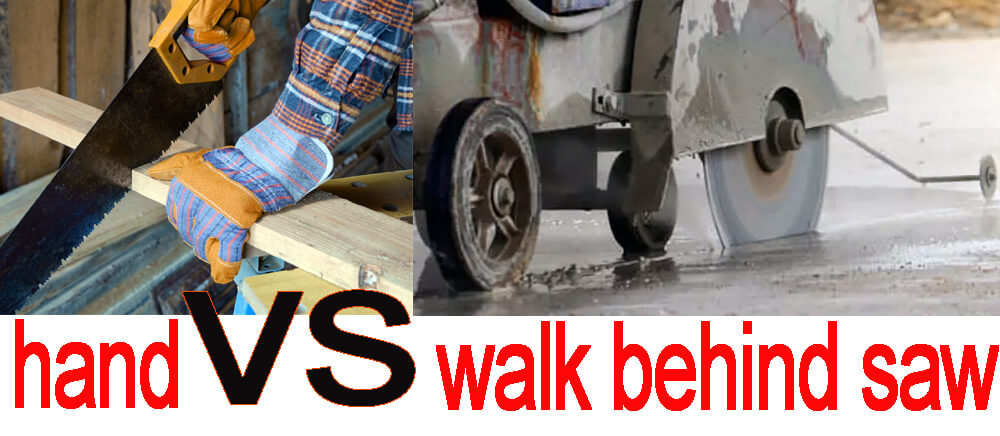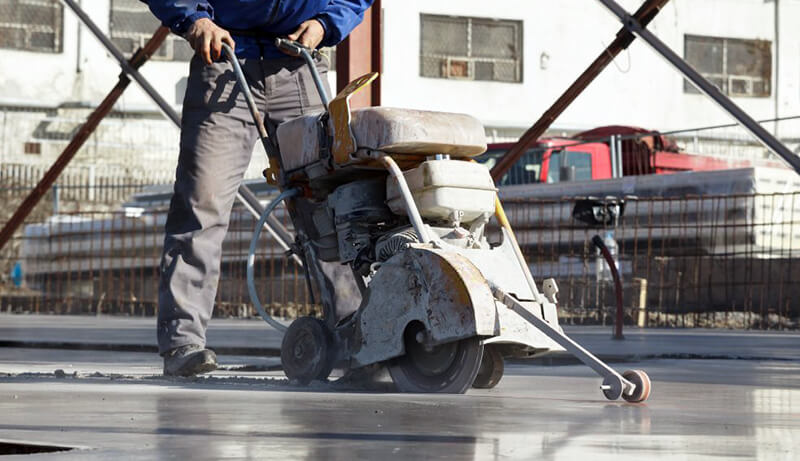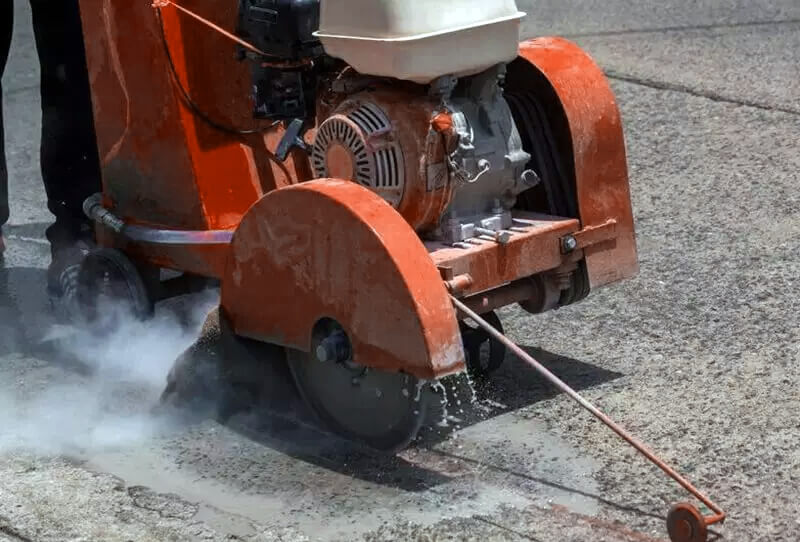02Mar 2024
table of contents

You have a job and wonder if you should use a hand or walk-behind saw. Which one will be the best? When deciding, it’s essential to know precisely what your job entails. Here are some aspects to know.
Concrete saw is specialized used to cut concrete, masonry, brick and asphalt etc solid materials. It could be hand held, or walk-behind. And it may be powered by gasoline, or in some cases, by an electric motor.
What diameter diamond saw blade can a concrete saw hold?
What size arbor are you running?
What blade/cut quality are you looking at?
Matching saw blade to the type of concrete you will be cutting (asphalt, metal rod reinforcement, aggregate concrete, etc.)
Do you want high-speed cutting?
Does longer life matter?
Horsepower: The more horsepower, the more impact the blade will experience while cutting.
In general, you’ll want a hand saw for portability. Short, quick cuts that don’t require specific precision often allow for a hand-held option.
This is the first choice for most concrete-cutting jobs. Typically come in 12" or 14" sizes and can be operated by various power sources, including a two stroke gas engine, a hydraulic power unit, an electric motor, or an air compressor.
The choice of power supply mainly depends on the application. And popular because they are lighter, quieter, and easier to use than cutting machines.
On the other side, hydraulic saws offer the best weight-to-power ratio. Although they are more expensive and less forgiving than pneumatic saws, they are useful because the majority of contractors have hydraulic power units.
Pneumatic saws are also handy since air compressors are available on most job sites. The operation is simple, and reduces potential risks. Despite their lightweight nature and low maintenance demands, their operation can be potentially costly, given the requirement for a compressor and diesel fuel to power them.
Hand saws are lightweight and compact nature, making them easy to transport and apply in various locations. Their operational independence from electricity or batteries adds to their versatility, offering unrestricted use in multiple settings.
There exists a diverse range of hand saws, each featuring unique types and blade configurations. This diversity enhances their adaptability, making them an appropriate choice for a variety of cutting operations.
With a hand saw, you have direct control over the cutting process. You can adjust the speed, angle, and pressure as per the material and the desired result.
Hand saws produce minimal noise and vibration compared to walk-behind saws.
Hand saws require manual work because you must manually provide the cutting force. This can be tiring, significantly, when cutting harder or thicker materials.
In comparison to their walk-behind counterparts, hand saws typically operate at reduced cutting speeds. This characteristic could potentially limit their effectiveness, particularly for larger projects or those with tight deadlines.
Hand saws have their limitations regarding cutting capacity. They may need help handling thicker or denser materials, and their cutting depth or width may be limited.
Chips and debris in the eyes
Due to the friction and power of the hand saw, small chips fly out that can quickly get into your eye and burrow deeper, potentially requiring surgery or, worse, blinding you.
When using a hand saw, flying splinters are always possible. Objects being sawed may sometimes bounce and hit the person using the handsaw. Always wear a safety mask and goggles to protect your face and eyes.
Mishandling tools due to size
Hand saws come in different sizes. Choosing a size that is not right for you could result in mishandling and, ultimately, injury to you or others.
Before cutting with your handsaw, you must first analyze the raw material. Handsaws that are too large or too small for the job should be avoided.
Tool failure that could lead to accidents
Hand sawing is a rigorous process that can sometimes stress the machine if used continuously for long periods. It may remain the same if appropriately checked before each use, resulting in an accident.
Prior to employing a handsaw, it is vital to conduct a thorough inspection for any noticeable defects. One should abstain from using a handsaw if any issues are observed, such as a loose handle, a bent or fractured blade, or absent teeth. Marking a tool as dangerous will also ensure no one else uses it.
Jammed material that could lead to hand saw failure and accidents
Due to the smaller size of the hand saw, knots and nails may be overlooked, which, if not checked before use, could cause the saw to malfunction and cause an accident.
Knots, metal bits, nails, and screws in stock have the potential to damage the blade. It can also cause the saw to bend, causing injury. You can avoid this by thoroughly inspecting the goods in advance.
Improper sharpness check
The temptation to hand-check that the blade is sharp for hand sawing is somewhat overlooked, but it’s one of the most common mistakes others make that cause cuts and injuries.
Never test the sharpness of a handsaw with your hand or any other part of your body. This can cause cuts and injuries.
Starting too fast
Starting the machine quickly and not gaining power before starting is a significant safety risk and can cause the blade to snap off or sharp pieces to fly out, which could injure you or others.
You must always start softly to avoid bending and kickback in the handsaw. To begin cutting through material, use long, even strokes.

A walk-behind saw is an important power tool for cutting concrete or masonry. They are traditionally used for sidewalks, asphalt, concrete driveways, basement floors, warehouse floors, highways, or any application that requires sawing-level concrete or asphalt. Walk-behind saws range from 14” up to 32”.
Walk-behind saws are typically driven by either a gasoline engine or an electric motor. Both power sources offer excellent cutting power.
Walk-behind saws are capable of cutting more profoundly and broader than hand saws.
Walk-behind saws offer faster cutting speeds than hand saws. With their powerful engines or motors, they can complete cutting tasks faster, making them suitable for time-sensitive jobs.
The walk-behind saw has features that increase precision and control during cutting.
walk-behind saws, by virtue of their design for heavier tasks, are larger and heavier compared to hand saws, which makes them less portable and more difficult to handle.
Walk behind saws produce noticeable noise and vibration during operation, which can be distracting and tiring.
Walk behind saws tend to be more expensive than hand saws. They require a more significant upfront investment, especially for high-quality models with powerful engines and advanced features.
A walk-behind saw requires proper training and skills to ensure safety and optimum performance.
Walk-behind saws are great for grooving and inlaying concrete slabs. Commonly used for trenching, patching, and other concrete and asphalt applications, these saws are very effective on heavy and stamped concrete.
If safety measures are not strictly adhered to, operating walk-behind saws can pose a risk. Anyone operating a walk-behind saw must be trained and authorized before using it.
Construction workers in rubber boots cut into the road with a walk-behind saw. It's essential to don appropriate Personal Protective Equipment whenever you're handling any walk-behind saw. Wear goggles, preferably goggles or safety glasses with side protection, and depending on the task, a face shield can provide additional protection. For stability, wear closed-toed work shoes, preferably steel-toed boots. Other PPE, including work gloves, dust masks, hearing protection, and knee or shin guards, may be recommended.
Before using any walk-behind saw, it starts with choosing the correct blade. Always use the proper or right blade for the material you're cutting. Ensure that the saw blade is well-maintained, remaining both clean and sharp. A dull or sticky blade is more likely to wrap around the cut. Stop using cracked or damaged saw blades.
After starting the engine:
Turn on the water valve for wet cutting, then slowly adjust the blade to the ground. The blade will gradually draw the saw in a forward direction.
According to guide steer the saw at a slowly pace.
Do not twist or change direction when cutting.
A smooth cut will ensure you don’t damage or break the blade. Stop the engine when the walk-behind saw is left unattended.
Use lifting lugs and proper lifting equipment to ensure safe movement or transport of the saw. Do not use the handlebar or front pointer as a lifting point. Never drag the saw behind a vehicle. Never transport the saw with the saw blade installed.
Pneumatic walk-behind saws emit deadly carbon monoxide gas and should never be used in enclosed or confined areas where airflow is restricted. Walk-behind saw burn fuel will release carbon monoxide, which can be lethal if used within closed environments. and the crucial to refuel in a well-ventilated and stay clear of any sparks or open flames to prevent accidents.
When using a walk behind saw to cut masonry, concrete or other materials containing silica, will generate inhalable dust consisting of crystalline silica. These minuscule silica particles can inflict irreversible harm to lungs upon inhalation. Therefore, to minimize dust production, according to the manufacturer’s instructions to minimize dust. Wet cutting is an effective way to reduce exposure to silica dust. Walk-behind saws should be equipped with an integrated water supply system that provides a continuous water supply to the saw blade. Nozzles must not be clogged or damaged and must function properly to spray water where dust is generated. Every hose and connection should be in complete and working order.

Of course, when choosing between a hand saw and a push saw, you need to consider the following factors:
The requirements of the project will greatly affect which type of saw is best. This includes:
Cut Depth and Length: Deeper and longer cuts usually require the use of a push saw with more powerful cutting capabilities. Shallow, short cuts can be adequately handled with a hand saw.
Material type: Hard substances such as concrete or masonry often necessitate the robustness and potency of a hand saw, while a hand saw can deftly address the cutting needs of softer materials like wood or plastic.
Speed: If your project is time-sensitive, a push saw’s faster cutting speed may be crucial.
Precision: For jobs that require high precision, a walk-behind saw with advanced controls may be the best choice.
Space constraints: In tight areas or indoor locations, the smaller size and higher maneuverability of a hand saw may be advantageous. Instead, a push saw may be a better choice for open spaces or outdoor projects.
Portability Requirements: Tasks necessitating repetitive relocation or operation of the saw across diverse spots are likely to be facilitated by the easy portability of a hand saw.
Noise and Vibration: In environments where noise and vibration must be minimized, a hand saw may be more suitable.
Hand saws generally require a higher investment than hand saws, so your budget may be the deciding factor in your choice. Remember to factor in the cost of maintenance, blades, and potential repairs in your budget.
Operating a handsaw requires more skill and experience than using a handsaw. You should take into account level of comfort and familiarity both you and your team have with these tools.
taking these factors into account will guide you in determining which type of saw—whether a hand saw or a walk-behind saw—is most suited to the unique needs of your particular project.
In summary, the principle of choosing the right tool for the task is crucial and always applies. Hand saws offer significant advantages in portability, versatility, and manual control. Walk-behind saws, on the other hand, pack a powerful punch when working with dense materials like concrete or masonry, making deeper and wider cuts quickly and accurately. Before making a decision, thoroughly understand your requirements and limitations.
If you're looking for a reliable, high quality walk behind saw to tackle your construction tasks, we strongly advocate for BISON walk behind saw. Don't hesitate to reach out to us for a comprehensive breakdown of more product features. BISON concrete saws are built on the basics of safety, efficiency, and quality, ensuring you get the most from your work while maintaining a safe environment. Contact us today – we’ll support your success.
inquiry form here
BISON BLOG, All the latest news and views from Bison Machinery.